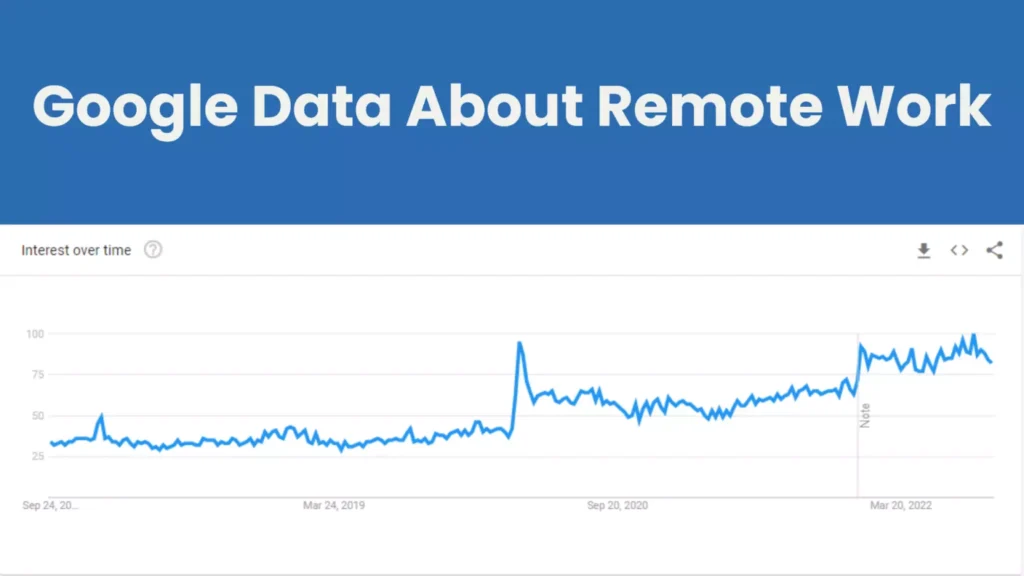Interesting Remote Work Statistics in 2022
Thinking about a workplace often brings the image of some adjacent cubicles under a roof. Now the idea of an office is rapidly changing. The rise of remote work has changed job search, recruitment, and work ethics. You may think of it as a sudden shift, but it has been there for the past 30 years.
Most companies prefer remote employees to in-house workers because the pandemic is speeding up this change. Working from home while sitting on your couch or lying in bed is the new normal. Many people are adapting to this new trend because of the value it brings to their lives.
However, some are still not in love with it. The fear of isolation makes them worry about their social life. Moreover, the fine line between work and personal life is blurred. Nonetheless, the phenomenon of working anywhere isn’t going to vanish. Sooner or later, you need to adapt to this routine.
So, if you are willing to shift to a remote job, you need to know some important insights. We have gathered some amazing remote work statistics for you.
Fascinating Remote Work Statistics
Remote work statistics are the data and facts about the work from home and virtual office environment. Individuals and think tanks gather data through research, case studies, and surveys and make sense of it to derive conclusions.
If this evolving office environment bothers you as an employer or an employee, there is everything you need to know. Certainly, you can make a rational decision after knowing these facts and figures.

Companies with 51-200 employees have the most remote workers (Insightful):
There has been a peculiar trend in adopting remote workers by companies in 2022. The stats of the remote 2022 report says that small to medium-sized companies have the highest number of remote employees.
Companies with 51-200 employees have 38.2% of the remote work base. This trend further lingers on to companies with 200+ employees, reaching 32% of the total.
The lowest remote headcount goes with large enterprises, but they have also shown significant growth in the past two years since the last published report in 2019.
We can imagine that remote workers will evolve from small groups and soon be adopted by large enterprises as a network of individuals.
71% of the employers will allow remote work to their employees (Stats of remote 2022 report):
Companies are concerned with productivity whether you work from home or the office. There we have seen a surging trend in companies allowing their workers to shift to remote work.
Employers have become much more flexible after the pandemic, and they understand the value of giving workers the opportunity of working remotely.
Therefore, these remote work statistics show that companies will have to adopt a hybrid model sooner or later.
21.38% of companies vote for the communication gap as the biggest problem in remote work (Stats of remote 2022 report):
Though the remote work statistics show a brighter side of virtual office work, it has some downsides. Communication ranks in the top position among many problems companies face in remote settings.
Nearly 21.38% of organizations’ leaders are concerned about collaboration as their biggest problem. Different time zones and employees’ productivity are 2nd and 3rd biggest problems.
American workers are getting 2.37% of work from any given day per week (WEF):
Even the highly competitive market of the USA can’t resist the penetration of remote work. Employees are asking their companies for more work-from-home days a week.
Companies have increased the remote working days to retain their workers from 1.58% to 2.37% on any given day per week.
In total, the companies must adopt a hybrid work model in the USA to meet the demand for remote work. Still, young individuals prefer going to the office as a platform to groom as a professional and learn social networking skills.
Melbourne (Australia) is the best-suited city for remote workers ( Global Remote work Index):
The remote work index compares the top 80 cities of the world. The cities are already considered the best for their work-related facilities and living standards.
The report employs some metrics deemed suitable for work from anywhere. These factors include remote working compliance, civic infrastructure, livability, and cost of living.
Melbourne gets the highest score in each metric and is the most suitable for remote workers.
Healthcare (15%), technology (10%), and Fintech (9%) are the top three industries with the most remote jobs (Owl Labs):
There is a common myth that most work-from-home jobs are in the IT sector. With the evolution of freelancing in the IT sector, there is an increasing number of jobs in digital marketing, web development, and cybersecurity.
It makes it the pioneer sector to offer remote jobs within and outside the country where the company is located. Later, after the pandemic, people are finding new space in the healthcare sector. Now health industry tops the list to offer remote jobs.
Similarly, most people turn their attention towards Fintech; now, Fintech has one of the most remote working jobs in the world. Gradually, you can see work from anywhere in industries like cybersecurity and data science.
These remote work statistics show the imminent increase of such jobs.
Working From Home UK Stats
following are the Working from home statistics in UK :

- People earning around £40,000 are more likely to adopt a hybrid model in the UK (ONS):
- According to recent data, the top earners in the income regime work from both office and home.
- As soon as the lockdown ended, most people came out of their houses to join the offices.
- Maybe they are bored staying at their homes, or their employers ask them to join the office.
- Still, the in-house workplace doesn’t remain consistent for them. Therefore, people adopt the hybrid model.
- In contrast, most low earners don’t have the luxury of working from anywhere.
- 78% of the workers in the UK report an improved work-life balance (ONS):
- Work-life balance is the most important aspect of any employee’s life.
- A myth attached to work-from-home experience is that it disrupts your work-life balance.
- You move to and fro between work, and you can’t clearly define the fine line between your work and personal life.
- But recent remote work statistics in the UK state that’s not the case anymore.
- According to their national statistics office, more than 78% of employees say remote work has improved their work-life balance.
- Around 50% voted for fewer distractions, and they were quick to complete work.
- 30% of the employees still work remotely in the UK in 2022 (Standout CV):
- According to a recent national survey, remote and hybrid workers will have decreased by 9% in 2022.
- But still, the number is rather encouraging. Among the total labor base, 3 out of 10 work from home.
- It’s important to note that the ability to go remote depends on certain factors.
- You may find it easy to work remotely in the digital marketing sector. Moreover, if you are young, you may find it best to join an in-house position.
- Therefore, age, industry, and position define whether you will do the remote job or join your office.
- 94% of the employees earning £50,000 can work from home if they wish (Standout CV):
- In the UK, the current remote work statistics show that your salary defines whether you have the privilege to work from home.
- People below the £20,000 income range per year don’t have the facility to choose between the office and home for their work.
- Only 5% of the £20,000 income workers have the choice to work from home. Rest have to come to the office.
- Income Statistics
Remote jobs have $4000 greater yearly income than office jobs (Flex Jobs):
The remote work income statistics show that working from the comfort of your home has some added benefits. Apart from the cut in the commute costs, you can earn $4000 more than an office worker.
The remote workers contributing to these statistics probably belong to high-income individuals. That’s why we see a huge gap in salaries. Nonetheless, remote work distinguishes the incomes and is suitable for most individuals.
Remote workers can cut their expenses by around $7000 compared to in-house (TECLA):
It is a no-brainer that working from home is the least expensive thing. When you work from your office, you have to travel, and your travel costs compound if your office is in a metropolitan area.
The reason is that you must frequently stop at traffic signals, move slowly through crowded areas, and travel more daily. So, your daily gas bills are an extra cost in your pockets when compared with remote work.
Moreover, you need to have your lunch daily at restaurants drawing away your money; however, you can cook simple food if you work from home. So, remote work is inexpensive and saves you a lot of money.
UK businesses save 45% on cleaning costs ( Standout CV):
Businesses also accrue benefits from the remote work environment. It’s not the employees that cut their costs to earn more money. Employers with a part-remote force can reduce office expenses as much as they need.
According to current remote work statistics, British companies save 45% on office cleaning costs and 36% on rent and utilities.
It is estimated that if London can change 20% of its office employee base to remote, the city can save £75000 per year.
Workplace distractions lose 28% of the productive time (The Economist):
Productivity is the biggest metric in any business success. We have seen startups boom in the world. But, most of them fail because they can’t pinpoint their productive energies on the right track.
It causes huge losses in business. According to the Economist, one-fourth of the productive time in a workplace is lost annually. It means the employees take extra time to complete their tasks, which burdens the monetary side of the business.
Figures show that a typical business utilizes 72% of working hours annually. The lost hours account for 581 per person daily hours per year.
Through statistical methods, the Economist has co-related the lost hours. The total aggregate of the lost productive money is around US$34,448 per person.
- Companies’ Behavior Towards Remote Work Statistics
More than 80% of the employers believe that remote work is good for business in 2022 (PwC):
83% of business owners believe that remote work has helped their companies become successful. They feel that it garners productivity and contributes to the efficiency of the employees.
As the workers are free from office stress, they work easily and complete the work in less time. Around 6% of US employers say they don’t think remote work benefits their business.
Chances of getting hired as a remote worker are two times the in-house jobs:
SMEs are always trying to find ways to cut down their expenses. Due to small budgets, they care about the least expenses in their offices.
That’s why they are more interested in hiring remote workers. Doing this saves some extra bucks from office maintenance, cleaning, and utilities.
Moreover, their employees need not pay any travel or food allowance. That’s the reason they prefer hiring remote workers.
64% of hiring managers believe that work from home policy brings high-quality talent (IWG):
You can see a significant trend of people from third-world countries getting jobs in silicon valley. Most of these jobs are remote-based. The struggling individuals from South Asia and the Middle East have better skills. They shift towards remote opportunities because they can’t find lucrative jobs in their region.
Moreover, virtual job boards have opened new gateways for companies to fetch the best talent across borders. Finding a remote person with strong skills but a relatively lower salary is the best choice for recruiters. Therefore, they hire them because it helps them to tap into global human resources.
- Remote Work Statistics of Employees
69% of remote employees face work-related stress (Strongdm):
For an individual, the workplace sounds like a crowdy place with an intense atmosphere.
They find it hard to cope with the overwhelming pressures of deadlines, unexpected meetings, employers’ scolding, office politics, and even workplace toxicity.
That’s why most workers try to avoid in-house jobs and choose remote ones. But, a remote job also comes with its drawbacks.
The major problem is burnout. It persists whether you choose a remote job or an office one.
Moreover, the failure to commit yourself or remain productive is another mental stress for individuals. The stats from a leading research agency show that 69% of remote workers cope with work-related issues.
79% of the employees believe in loyalty to the employer if they get workplace flexibility (Flexjobs):
Nowadays, hiring talented individuals is not an issue; however, retaining them for years is the main issue.
Skillful employees find jobs easily. So, if they find any issue with the employer, they take no time to shift to another job. The more facilities you provide your employees, the more they remain loyal to you.
According to research by Flexjobs, 79% of respondents say that they will remain loyal to their company if given flexible work.
Final Words - Remote Work Statistics
Remote jobs are trending today. When we say remote, we don’t confine remote work to one country. Remote jobs have shown an exchange of human resources across the globe. So, now any skillful person sitting in some remote area of Tibet can get a job in New York.
It has never been possible a few decades back. If you hope to shift to remote jobs, you must know the new insights in 2022.
This article discusses a long list of remote work statistics to inform you about the market and its possible benefits and drawbacks. Kindly let us know your feedback once you go through this article.
Read More : Best HR Software for Small Business 2022
Read More : Employee Tracking Software – The Best Solutions in 2022
